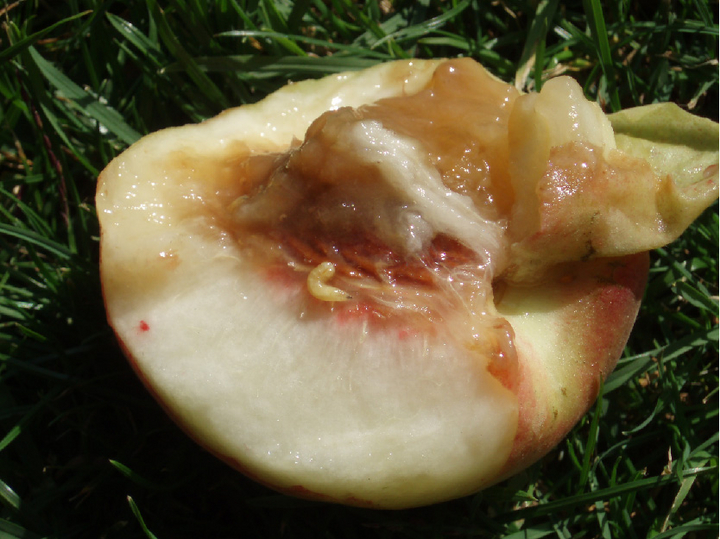
Fruit Fly
Ceratitis Capitata
Pathogen:
Insect
Type:
Risk:
CRITICAL





DESCRIPTION
Pathogen description
Ceratitis capitata, known as the fruit fly, is an insect of the Tephritidae family. The female fruit fly lays her eggs under the skin of ripe fruits, using her ovipositor. Each female can lay up to 300 eggs throughout her life. These eggs hatch into larvae that feed on the pulp of the fruit, causing significant damage. After several weeks of feeding, the larvae emerge from the fruit and burrow into the soil to pupate. The pupal stage lasts between 1 to 2 weeks, depending on environmental conditions. Then, the adults emerge, mate and restart the cycle. Adults can live for several weeks and are highly mobile, allowing them to disperse widely.
Disease description
The fruit fly, Ceratitis capitata, causes significant damage to peaches, peaches and nectarines, affecting both the quality and quantity of the harvest. The larvae feed on the inside of the fruit, causing decomposition and favoring the entry of pathogenic microorganisms.
- Taches on the skin of the fruit where the female has laid her eggs.
- Fruits with holes and soft areas due to larvae feeding.
- Fruits fallen prematurely from the tree.
- Appearance of secondary rot in infested fruits.
- Reduction in the commercial value of the fruit due to internal damage.

TEMPERATURE AND HUMIDITY
20-30 °C
60-80 %

VOIES DE TRANSMISSION
Movement of infected fruits, dispersal of flying adults, transport of contaminated soil, accidental introduction into new areas

Chemical treatments
CONTROL
• PARAFFIN OIL (CAS [64742-46-7]) 79% [EC] P/V
• AZADIRACTIN 1% (AS AZADIRACTIN A) [EC] P/V
• Azadirachtin 2.6% (AS AZADIRACTIN A) [EC] P/V
• CAOLIN 99% [WP] P/P
• DELTAMETHRIN 0.015% [RB] P/P
• DELTAMETHRIN 0.015g/trap [RB] P/P
• DELTAMETHRIN 0.03% (10 mg s.a./dispenser) [RB] P/P
• DELTAMETHRIN 1.5% [EW] P/V
• DELTAMETHRIN 1.57% [SC] P/V
• DELTAMETHRIN 10% [EC] P/V
• DELTAMETHRIN 2.5% [EC] P/V
• DELTAMETHRIN 2.5% [EW] P/V
• ESFENVALERATO 0.04 g/trap [RB] P/P
• LAMBDA CYHALOTHRIN (0.0075 g s.a./trap) [RB] P/P
• LAMBDA CYHALOTHRIN 1.5% [CS] P/V
• LAMBDA CYHALOTHRIN 10% [CS] P/V
• LAMBDA CYHALOTHRIN 2.5% [WG] P/P
• LAMBDA CYHALOTHRIN 5% [EG] P/P
• HYDROLYZED PROTEINS 30% [SL] P/V
• HYDROLYZED PROTEINS 36% [SL] P/V
• HYDROLYZED PROTEINS 5.9% [AL] P/V
• SPINOSAD 0.024% [CB] P/V
• Ceratitis capitata (Pheromone)
• TRAPS
• TRAPS FOR DIPTERANS
• FRUIT FLY TRAPS
Treatments authorized in organic farming
• PARAFFIN OIL (CAS [64742-46-7]) 79% [EC] P/V
• AZADIRACTIN 1% (AS AZADIRACTIN A) [EC] P/V
• Azadirachtin 2.6% (AS AZADIRACTIN A) [EC] P/V
• CAOLIN 99% [WP] P/P
• DELTAMETHRIN 0.015% [RB] P/P
• DELTAMETHRIN 0.015g/trap [RB] P/P
• LAMBDA CYHALOTHRIN (0.0075 g s.a./trap) [RB] P/P
• LAMBDA CYHALOTHRIN 1.5% [CS] P/V
• LAMBDA CYHALOTHRIN 10% [CS] P/V
• LAMBDA CYHALOTHRIN 2.5% [WG] P/P
• LAMBDA CYHALOTHRIN 5% [EG] P/P
• HYDROLYZED PROTEINS 30% [SL] P/V
• HYDROLYZED PROTEINS 36% [SL] P/V
• HYDROLYZED PROTEINS 5.9% [AL] P/V
• SPINOSAD 0.024% [CB] P/V
• Ceratitis capitata (Pheromone)
• TRAPS
• TRAPS FOR DIPTERANS
• FRUIT FLY TRAPS
Biological control
• BEAUVERIA BASSIANA (STRAIN ATCC 74040) 2.3% (2.3X10E7 VIABLE SPORES/ML) [OD] P/V
Preventive treatments
• BEAUVERIA BASSIANA (STRAIN ATCC 74040) 2.3% (2.3X10E7 VIABLE SPORES/ML) [OD] P/V
• Ceratitis capitata (Pheromone)
• TRAPS
• TRAPS FOR DIPTERANS
• FRUIT FLY TRAPS
- Monitor the presence of fruit flies using chromotropic and pheromone traps.
- Collect and destroy all fallen and damaged fruits to reduce the source of infestation.
- Implement the use of mesh or protective covers on trees to prevent flies from accessing the fruits.
- Carry out specific chemical treatments at the appropriate time to control adult populations.
- Use biological control techniques, such as the release of sterile males, to reduce pest reproduction.
- Maintain good garden hygiene, eliminating remains of previous crops and weeds.
- Apply cold treatments to collected fruits to kill any larvae present.
Recommendations
*The recommended treatments are recommendations based on the authorities' databases and do not replace in any way the guidelines established by the legislation of each country.





